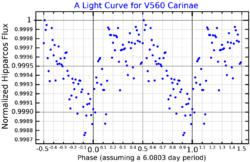Astronomy:HD 93205
Location of HD 93205 (circled), southwest of Eta Carinae, the brightest star in the image | |
| Observation data Equinox J2000.0]] (ICRS) | |
|---|---|
| Constellation | Carina |
| Right ascension | 10h 44m 33.739s[1] |
| Declination | −59° 44′ 15.43″[1] |
| Apparent magnitude (V) | 7.75[2] |
| Characteristics | |
| U−B color index | −0.91[2] |
| B−V color index | +0.05[2] |
| Variable type | Ellipsoidal[3] |
| Astrometry | |
| Radial velocity (Rv) | 3.6 km/s |
| Proper motion (μ) | RA: −6.619[1] mas/yr Dec.: 2.947[1] mas/yr |
| Parallax (π) | 0.4308 ± 0.0248[1] mas |
| Distance | 7,600 ± 400 ly (2,300 ± 100 pc) |
| Orbit | |
| Period (P) | 6.0803 days |
| Eccentricity (e) | 0.370 |
| Inclination (i) | 60[4]° |
| Semi-amplitude (K1) (primary) | 132.6 km/s |
| Semi-amplitude (K2) (secondary) | 313.6 km/s |
| Details | |
| Mass | 40 - 60[5] M☉ |
| Radius | 9.2[4] R☉ |
| Luminosity | 1,160,000[6] L☉ |
| Temperature | 51,300[6] K |
| secondary | |
| Mass | 17 - 25.3[5] M☉ |
| Radius | 7.0[4] R☉ |
| Luminosity | 112,000[6] L☉ |
| Temperature | 38,000[6] K |
| Age | < 2[5] Myr |
| Other designations | |
| Database references | |
| SIMBAD | data |
HD 93205, or V560 Carinae, is a binary stellar system, in the Carina Nebula (NGC 3372) in the constellation Carina. It consists of two massive O-stars that revolve around each other in 6 days.
The more massive member of the pair is an O3.5 main sequence star. The spectrum shows some ionised nitrogen and helium emission lines, indicating some mixing of fusion products to the surface and a strong stellar wind. The mass calculated from apsidal motion of the orbits is 40 to 60 M☉. This is somewhat lower than expected from evolutionary modelling of a star with its observed parameters.[5]
The less massive member is an O8 main sequence star of approximately 20 M☉.[4] It moves in its orbit at a speed of over 300 km/s and is considered to be a relativistic binary, which causes the apses of the orbit to change in a predictable way.[6]
The closeness of the two stars causes them to become deformed, and this means that the observed brightness of the system varies slightly every six days during its orbit. The total amplitude of the variation is only 0.02 magnitudes.[3]
It is generally considered as a member of the open cluster Trumpler 16.[8] Among its neighbors are some of the most massive and luminous stars in the galaxy, like Eta Carinae, HD 93250 and the binary WR 25. It lies five arc-minutes from Eta Carinae.
References
- ↑ 1.0 1.1 1.2 1.3 1.4 Brown, A. G. A. (2021). "Gaia Early Data Release 3: Summary of the contents and survey properties". Astronomy & Astrophysics 649: A1. doi:10.1051/0004-6361/202039657. Bibcode: 2021A&A...649A...1G. Gaia EDR3 record for this source at VizieR.
- ↑ 2.0 2.1 2.2 Ducati, J. R. (2002). "VizieR Online Data Catalog: Catalogue of Stellar Photometry in Johnson's 11-color system.". CDS/ADC Collection of Electronic Catalogues 2237. Bibcode: 2002yCat.2237....0D.
- ↑ 3.0 3.1 Samus, N. N. et al. (2009). "VizieR Online Data Catalog: General Catalogue of Variable Stars (Samus+ 2007-2013)". VizieR On-line Data Catalog: B/GCVS. Originally Published in: 2009yCat....102025S 1. Bibcode: 2009yCat....102025S.
- ↑ 4.0 4.1 4.2 4.3 Antokhina (2000). "Light Curve Solution of HD 93205 (O3 V + O8 V) Containing the Earliest Known Star in a Well-studied Binary". The Astrophysical Journal 529 (1): 463–476. doi:10.1086/308228. Bibcode: 2000ApJ...529..463A.
- ↑ 5.0 5.1 5.2 5.3 Cite error: Invalid
<ref>tag; no text was provided for refs namedbenvenuto - ↑ 6.0 6.1 6.2 6.3 6.4 Cite error: Invalid
<ref>tag; no text was provided for refs namedmorrell - ↑ "Hipparcos Tools Interactive Data Access". ESA. https://www.cosmos.esa.int/web/hipparcos/interactive-data-access.
- ↑ Shull, J. Michael; Darling, Jeremy; Danforth, Charles W. (2021). "Gaia EDR3 Parallax Distances to the Great Carina Nebula and Its Star Clusters (Trumpler 14, 15, 16)". The Astrophysical Journal 914 (1): 18. doi:10.3847/1538-4357/abf4d8. Bibcode: 2021ApJ...914...18S.
 |



